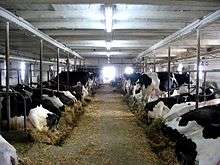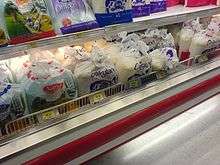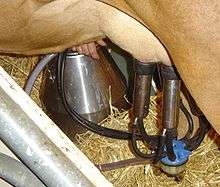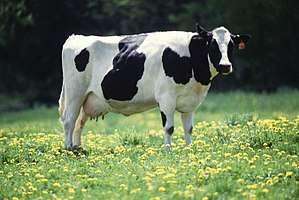Dairy farming in Canada

Dairy farming is one of the largest agricultural sectors in Canada. Dairy has a significant presence in all of the provinces and is one of the top two agricultural commodities in seven out of ten provinces.[1]
In 2017, there were 945,000 dairy cows on 10,951 farms across the country.[2] Quebec and Ontario are the major dairy producing provinces, with 49% and 33% of the farms as well as 37% and 33% of the milk production being present in these provinces, respectively.[3] This is supposed to represent 8% of farmers in Canada.[4] While dairy farming is still prominent in Canadian society, the number of dairy farms in Canada has been dropping significantly since 1971 while the size of the average farm has significantly increased.[5][6]
The Canadian dairy sector contributes approximately $18.9B yearly to Canada's GDP, and sustains approximately 215,000 full-time equivalent jobs.[7] On average, two-thirds of Canadian dairy produced is sold as raw milk while the remaining one-third is refined into other dairy products such as milk, cheese and butter.[8]
In Canada, dairy farming is subject to the system of supply management. Under supply management, which also includes the egg and poultry sectors, farmers manage their production so that it coincides with forecasts of demand for their products over a predetermined period - while taking into account certain imports that enter Canada, as well as some production which is shipped to export markets. Imports of dairy, eggs, and poultry are controlled using tariff rate quotas, or TRQs. These allow a predetermined quantity to be imported at preferential tariff rates (generally duty free), while maintaining control over how much is imported. The over-quota tariffs are set at levels that should allow Canadian farmers to receive a price reflecting the cost to produce in the country.[9]
While there has been some pushback regarding the supply management system, research indicates that the Canadian population generally have varied views with the current system.[10][11][12]
History
The Canadian Dairy Farmers' Federation was founded in 1934. The group became Dairy Farmers of Canada in 1942, and its mandate was to stabilize the dairy market and increase revenues for dairy farmers.[13] In the face of lobbying, government programs were instituted in the 1940s and 1950s to increase prices and limit imports. 1958 saw the creation of the Agricultural Stabilization Board, though it was not limited to dairy.[5] In the 1950s and 1960s there was significant volatility in dairy prices; dairy producers were seen as having too much bargaining power relative to dairy farmers, and the United Kingdom was poised to enter the European Common Market, resulting in the loss of Canada's largest dairy export partner. These challenges led to the creation of the Canadian Dairy Commission, whose mandate was to ensure the quality and supply of milk, that producers received a "fair" return on investment, and set prices based on production costs, market price, consumer's ability to pay, and current economic conditions.[14]
Supply management
The government of Canada put in place a supply management system during the early 1970's, as an effort to reduce the surplus in production that had become common in the 1950s and 1960s, and to "ensure" a fair return for farmers.[15]

Supply management is a shared jurisdiction between the Federal and Provincial governments. For example, on a Canada-wide basis, there is the Canada-wide Canadian Dairy Commission, composed mostly of dairy farmers, while in Ontario there is the Dairy Farmers of Ontario. Other provinces also have similar local boards.[9]
In 1983, the National Milk Marketing Plan came into effect to control supply, setting guidelines for calculating Market Sharing Quota. This agreement is between the federal and provincial powers. The Milk Marketing Plan was created to replace the Comprehensive Milk Marketing Agreement, which was initially established in 1971. By 1983, every province except Newfoundland had signed onto the Milk Marketing Agreement.[16] Following dairy, a national supply management system was implemented for eggs in 1972, turkey in 1974, chicken in 1978 and chicken hatching eggs in 1986.[9]
The basic idea behind supply management is to manage production so that supply is in balance with demand, and the farm gate price enables farmers to cover their costs of production, including a return on labour and capital.[9]
Each farm owns a number of shares in the market (quota), and is required to increase or decrease production according to consumer demand. Because production is in sync with demand, overproduction is avoided; this enables farmers to earn a predictable and stable revenue, directly from the market.[9]
A supply management system for Canadian dairy products is beneficial to Canadian dairy farmers however, the consequence of such a system is artificially higher dairy prices in Canada which has shown to affect the consumption of dairy products in Canada. Due to higher prices, individuals are consuming lower amounts of dairy products and instead consuming dairy substitutes, such as almond or soy milk, at a higher rate.[17]
Also, there is concern regarding the impact that supply management has on political influence, given that the number of dairy farmers in Canada has been significantly dropping since 1971, the percentage of dairy farmers compared to other farmers in Canada, the amount spent to protect the system and the tactics used, the electoral clout that dairy farmers have on elections, as well as the fact that the average dairy farmer have become significantly wealthier in term of net worth.[4][5][18] These groups also feel like that the system also be done away in order to increase food manufacturing, reduce food waste, tackling poverty and prevent future food shortages.[19][20][21][22] In addition, the Canadian dairy system makes Canadian dairy farmers unable to participate in the global dairy market potentially limiting their expansion if they could compete with artificially low international milk prices and should be done away with in light of Canada's commitment to free trade.[5]
Canadian Dairy Farming Regulations
Canadian dairy farmers have strict regulations outlined by the Canadian Food Inspection Agency to ensure proper oversight of dairy production and to guarantee that strict standards of biosecurity are upheld. These regulations provide clear guidelines for Canadian dairy farmers to adhere to in order for them to ensure biosecurity standards are maintained in the sectors of environmental protection, human health, animal health, and animal welfare. In adhering to these regulations, dairy farmers can make certain that dairy standards are sustained, ensuring satisfaction for consumers of Canadian dairy products.[23] Under the 2015 TPP negotiations it was revealed that Health Canada had not found evidence of adverse health effects in humans from the consumption of rBST growth hormone products. Without a labeling requirement If Canadians chose to only consume Canadian dairy products in order to avoid consuming rBST, there would be no way of knowing the origins of milk ingredients. Processed food sold in Canada could contain ingredients from cows from the U.S. that were treated with rBST.[24]
Canadian Dairy Farming and Environmental Impact

The Canadian dairy industry is responsible for 20% of total green house gas (GHG) emissions generated in Canada by livestock agriculture, which is made up of the dairy, poultry, swine and beef industry.[8] 90% of the GHG emissions caused by Canadian dairy farming occurs as a result of events on the farm, whereas only 10% GHG emissions are emitted as a result of off farm processes such as the producing and refining processes.[8] The greatest amount of GHG that is produced by Canadian dairy cows occurs at the time of lactation.[25]
GHG emissions from dairy farms in Western Canada are typically lower than in Eastern Canada, primarily as a function of climate and raw milk production processes in comparison to the climate and milk production processes utilized in Eastern Canada. Consequently, the Eastern provinces of Canada contribute to 78.5% of GHG emissions created by the Canadian dairy farming industry.[8]
Canadian Dairy Farming, Feed Sources, and Greenhouse Gas Emissions
The type of feed utilized by Canadian dairy farmers significantly affects the amount of GHG emissions as a result of dairy production. Canadian dairy farmers commonly feed their cattle corn or barley silage as high nutrient food sources to increase milk production. Although corn and barley are both efficient and economic sources of feed, these two feed sources are responsible for large amounts of greenhouse gas (GHG) emission in Canada. While both of these types of feed contribute to significant amounts of GHG, research reveals that corn produces lower amounts of GHG in comparison to barley.[26] In examining the use of these two types of feed, comparison of measurements of CH4, N2O and CO2 suggests that total GHG emission in Canada produced by a single cow based on amount of milk production is 13% lower when the cow is fed corn compared to barley. Additionally, corn silage feed is attributed to higher milk production across dairy cows compared to barley silage feed.[26]
Despite the decrease in GHG in utilizing corn feed for Canadian dairy farms, when examining processing and transportation costs of feed for Canadian dairy farms, corn silage production is responsible for a 9% increase in CO2 compared to the processing and transportation costs associated with barley silage production. Despite higher rates of GHG due to transportation costs, Corn still results in lower rates of GHG overall.[26]
While corn and barley are two commonly used types of feed by Canadian dairy farmers, the feed source of the forage, alfalfa, while less commonly used is a feed source that would further decrease GHG emissions, in comparison to corn.[27]
Organic dairy farming in Canada

Both organic and conventional dairy farms exist across Canada. Organic dairy farming in Canada is far less prevalent however, this is primarily due to widely held misconceptions that organic farming is unprofitable and risky, as organic farming is attributed to a significant degree of self-sufficiency for all aspects of production. Consequently, conventional farming is perceived as being highly advanced technologically, utilizing efficient fertilizers and automated processes throughout the farm, driving down costs associated with physical labour. Conventional farming is, therefore, widely perceived as being the more modern and economically successful method of dairy farming in Canada.[28]
Contrary to this belief, costs associated with organic farming are substantially lower than costs incurred by conventional farming. Organic Canadian dairy farms have been shown to have a lower overall cost of production and are more self-sufficient in terms of plant and animal nutrient recycling and restocking of livestock herds. In contrast, the larger economic surplus enjoyed by conventional dairy farms in Canada is often offset by extra costs associated with importing fertilizers, seed, and replacement cattle, making conventional farming no more economically profitable than organic farming.[28]
Statistics
Snapshot of Canadian Dairy Industry, 2015[3]
| Province | Number of Dairy Farms | Number of Dairy Cows | Production (hectolitres) | Dairy Cows per Farm | Production (hectolitres) per Farm |
|---|---|---|---|---|---|
| British Columbia | 437 | 75,100 | 7,221,505 | 172 | 16,525 |
| Alberta | 547 | 77,900 | 7,015,384 | 142 | 12,825 |
| Saskatchewan | 163 | 27,100 | 2,426,736 | 166 | 14,888 |
| Manitoba | 299 | 44,700 | 3,450,720 | 150 | 11,540 |
| Ontario | 3,834 | 318,700 | 26,921,164 | 83 | 7,022 |
| Quebec | 5,766 | 354,100 | 30,016,781 | 61 | 5,206 |
| New Brunswick | 354 | 18,500 | 1,394,496 | 90 | 6,769 |
| Nova Scotia | 225 | 23,200 | 1,804,153 | 103 | 8,019 |
| Prince Edward Island | 174 | 14,300 | 1,032,523 | 82 | 5,934 |
| Newfoundland & Labrador | 32 | 6,000 | 483,413 | 188 | 15,107 |
| CANADA | 11,683 | 959,600 | 81,766,876 | 82 | 6,999 |
See also
References
- ↑ "An Overview of the Canadian Agriculture and Agri-Food System 2012; Agriculture and Agri-Food Canada".
- ↑ Government of Canada. (2017). Number of farms, dairy cows and heifers. Retrieved from http://www.dairyinfo.gc.ca/index_e.php?s1=dff-fcil&s2=farm-ferme&s3=nb
- 1 2 "Canadian Dairy Information Centre; Dairy Facts and Figures; Number of Farms, Dairy Cows and Heifers".
- 1 2 "Ending supply management: An opportunity for Canada". www.newswire.ca. Retrieved 2018-05-06.
- 1 2 3 4 Hall Findlay, Martha; Margarita Gres (June 2012). "SUPPLY MANAGEMENT: PROBLEMS, POLITICS – AND POSSIBILITIES" (PDF). The School of Public Policy SPP Research Papers. University of Calgary School of Public Policy. 5 (19): 1–33. Archived from the original (PDF) on October 21, 2013. Retrieved October 19, 2013.
- ↑ https://www150.statcan.gc.ca/n1/daily-quotidien/170510/dq170510a-eng.htm
- ↑ "Dairy Farmers of Canada "Our Economic Contribution"".
- 1 2 3 4 Vergé, X. P. C., Maxime, D., Dyer, J. A., Desjardins, R. L., Arcand, Y., & Vanderzaag, A. (2013). Carbon footprint of Canadian dairy products: Calculations and issues. Journal of Dairy Science, 96(9), 6091 - 6104. DOI: 10.3168/jds.2013-6563
- 1 2 3 4 5 Heminthavong, K (2015). Canada's supply management system. Retrieved from https://lop.parl.ca/Content/LOP/ResearchPublications/2015-138-e.pdf
- ↑ "Supply Management: Most Canadians say scrapping system should be on the table during NAFTA talks - Angus Reid Institute". Angus Reid Institute. 2017-08-01. Retrieved 2018-05-06.
- ↑ "Canadians' opinions mixed on supply management". Policy Options. Retrieved 2018-05-06.
- ↑ Dairy Farmers of Canada. (2017). Why supply management works for Canadians. Retrieved from https://www.dairyfarmers.ca/what-we-do/supply-management/why-supply-management-works-for-canadians
- ↑ "Our History". Dairy Farmers of Canada. Retrieved October 19, 2013.
- ↑ "Milk, for all it's worth: How prices are set", The Chronicle Herald, December 21, 2013, retrieved June 14, 2018
- ↑ "Dairy Farmers of Canada, Our History".
- ↑ Canadian Dairy Commission. (2006). The Canadian dairy commission: a 40-year retrospective. Retrieved from http://www.cdc-ccl.gc.ca/CDC/userfiles/file/CDC's%2040th%20Anniverary%20Book.pdf
- ↑ Busby, C. & Schwanen, D. (2013). Putting the market back in dairy marketing. Commentary – C.D. Howe Institute, (374), Retrieved from http://proxy.library.carleton.ca/login?url=https: //search -proquest-com.proxy.library.carleton.ca/docview/1322893997?accountid=9894
- ↑ "Time to end Canada's milk, egg and poultry protectionism | The Star". thestar.com. Retrieved 2018-05-06.
- ↑ "Supply management costs poor families five times more relative to household income: study". National Post. 2015-02-27. Retrieved 2017-12-17.
- ↑ "'Cheese ninjas' to the rescue: Why Canada's supply management system needs reform". Financial Post. 2017-12-20. Retrieved 2017-12-20.
- ↑ "Supply management is literally driving tens of thousands of Canadians into poverty". Financial Post. 2016-08-31. Retrieved 2018-01-08.
- ↑ "Why is Canada letting dairy farmers imperil NAFTA?". Retrieved 2017-12-06.
- ↑ Canadian Food Inspection Agency (2013). Biosecurity for Canadian dairy farms: National standard. Retrieved from http://books1.scholarsportal.info.proxy .library.carleton.ca/viewdoc.html?id=/ebooks/ebooks0/gibson_cppc/2013-06-28/1/10690986#tabview=tab1
- ↑ McGregor, Janyce (October 5, 2015). "Trans-Pacific Partnership offers dairy sector good news, bad news and a question mark: The deal marks a nudge toward competitive change, but more uncertainty than the dairy sector is used to". CBC News. Retrieved July 11, 2018.
- ↑ Mc Geough, E. J., Little, S. M., Janzen, H. H., McAllister, T. A., McGinn, S. M., & Beauchemin, K. A. (2012). Life-cycle assessment of greenhouse gas emissions from dairy production in eastern canada: A case study. Journal of Dairy Science, 95(9), 5164. http://dx.doi.org/ 10.3168/jds.2011-5229
- 1 2 3 Guyader, J., Little, S., Kröbel, R., Benchaar, C., & Beauchemin, K. A. (2017). Comparison of greenhouse gas emissions from corn- and barley-based dairy production systems in Eastern Canada. Agricultural Systems, 152, 38-46. DOI: 10.1016/j.agsy.2016.12.002
- ↑ Hawkins, J., Weersink, A., Wagner-Riddle, C., & Fox, G. (2015). Optimizing ration formulation as a strategy for greenhouse gas mitigation in intensive dairy production systems.Agricultural Systems, 137, 1-11. 10.1016/j.agsy.2015.03.007
- 1 2 Stonehouse, D. P., Clark, E. A., & Ogini, Y. A. (2001). Organic and conventional dairy farm comparisons in Ontario, Canada. Biological Agriculture & Horticulture, 19(2), 115-125. DOI: 10.1080/01448765.2001.9754916